Hello mga ka-Triton! Whether you are a driver or a pedestrian, knowing the different road markings in the country is a must. Learning them will keep you safe and knowledgeable with traffic rules. Violating them will score you expensive penalties or some jail time.
But what are they exactly?
Road markings or road surface
markings are lines that convey information and guide drivers and pedestrians.
There are 17 road markings common in the Philippines, and we will talk about
them.
1. Solid White Shoulder Line
This marking signifies the edge of the road. Anywhere beyond
this line should be out of your vehicle’s operation. Always drive within this
line.
2. Diagonal White Line
Diagonal White Lines are areas bordered by solid white
lines. This marking means that the area is not part of the roadway, and drivers
are expected to stay clear. Oftentimes, diagonal white lines help ease the flow
of traffic where roads intersect or diverge.
3. Broken White Center Line or Lane Divider
As the name suggests, these series of broken white lines in
the middle of the road divides the lanes for incoming and outgoing traffic.
Straddling to the other side can cause an accident, and it is punishable by the
law.
I can’t stress this enough but, STAY IN YOUR LANE WHEN
DRIVING.
4. Solid White Center Line
It divides the traffic into two-way multi-lane roads. You
should also avoid overtaking over this line unless the road ahead is clear, or
else you will cause an accident.
5. Solid White Double Center Line
Never attempt to overtake on these lines at any time.
Left-hand turns are only allowed when the road ahead is clear. But do keep in
mind that the other side always has the right of way.
6. Solid Yellow Double Center Line
You will find these lines around blind curves or inroads
where fast-moving two-way traffic meets on an undivided road. Like with its
white counterpart, it is best to avoid overtaking it.
7. Mixed Center Line/Solid Yellow with Broken Yellow or White Line
These lines signal that only one side can overtake, the side
with the broken lines. You will commonly find them when entering curves with an
obstructed view from one direction but clear on the opposite side.
8. Solid White Lane Divider
Solid White Lane Dividers are found when you are near
intersections. It is easy to confuse it with Solid White Center Lines, but the
best indication for it is that it will have a turning lane 50 meters before
intersections with a broken divider lane. You must slow down when approaching
them and start making the turn slowly. Again, this line serves as a reminder
for you to stay in your lane.
9. Directional Arrows
These white arrow markings are always found with the solid
white lane dividers. The arrows tell you which direction the lanes go. It can
point you straight forward. Or it can signal you that the lane you are
following follows a turn. Don’t ignore these arrows because you will receive a
ticket at best and an accident at worst.
10. Broken Blue Line Divider
It indicates the motorcycle lane. These lines mean that
drivers can move in and out. Although only motorcycles should use the space
between the broken blue lines.
11. Pedestrian Lanes
Pedestrian Lanes are your best
buddies when crossing roads on foot. Always use them for a safe road crossing.
As for drivers, we advise you to stop your car before the Solid White
Horizontal Line when a pedestrian is crossing or when the traffic lights are
red.
12. Solid White Horizontal Line
The thick solid white lines appear before pedestrian lanes or intersections with stoplights or stop signs. It signals you, the driver, to stop before it when the stop lights are red or when pedestrians are crossing.
13. Solid Yellow Lane Divider
On EDSA, this line marks as the bus lane.
14. Broken Yellow Lane Divider
These broken lines indicate areas where you can merge into
the bus lane in preparation for turning away from EDSA.
15. Mixed Double Lane Divider/Solid Yellow with Broken Yellow or White Line
These lines indicate that the cars on the solid yellow side
cross lanes, while vehicles on the other side can if the way is clear. You will
find them in areas where smaller arteries merge into main roads or where feeder
roads merge onto the highway.
16. Rumble Strips
These tight-spaced lines indicate hazards ahead your way.
Such hazards could be dangerous curves or merging traffic. And as its name
suggests, you will feel a rumble when your car passes through these lines.
17. Yellow Box
This yellow box with a large x-mark or huge crisscrosses
indicates an intersection. By all accounts of the law, this area must always be
kept open. No car should ever stop on it, or there will be penalties for the
driver. So make sure you don’t get caught inside it.
We hope that you find this useful for a safe driving
experience. Because you know, a lot of accidents happen each year. But together,
we can reduce these numbers to make all roads as safe as they can be.
And if you happen to be a contractor or a civil engineer, we
highly suggest that you make roads safer by creating road marks using our
Triton Traffic Paint Products. You can leave us a message on our Facebook Page
to learn more.
Thank you for lounging with us, and we bid you a happy and
safe trip.


















Comments
Post a Comment